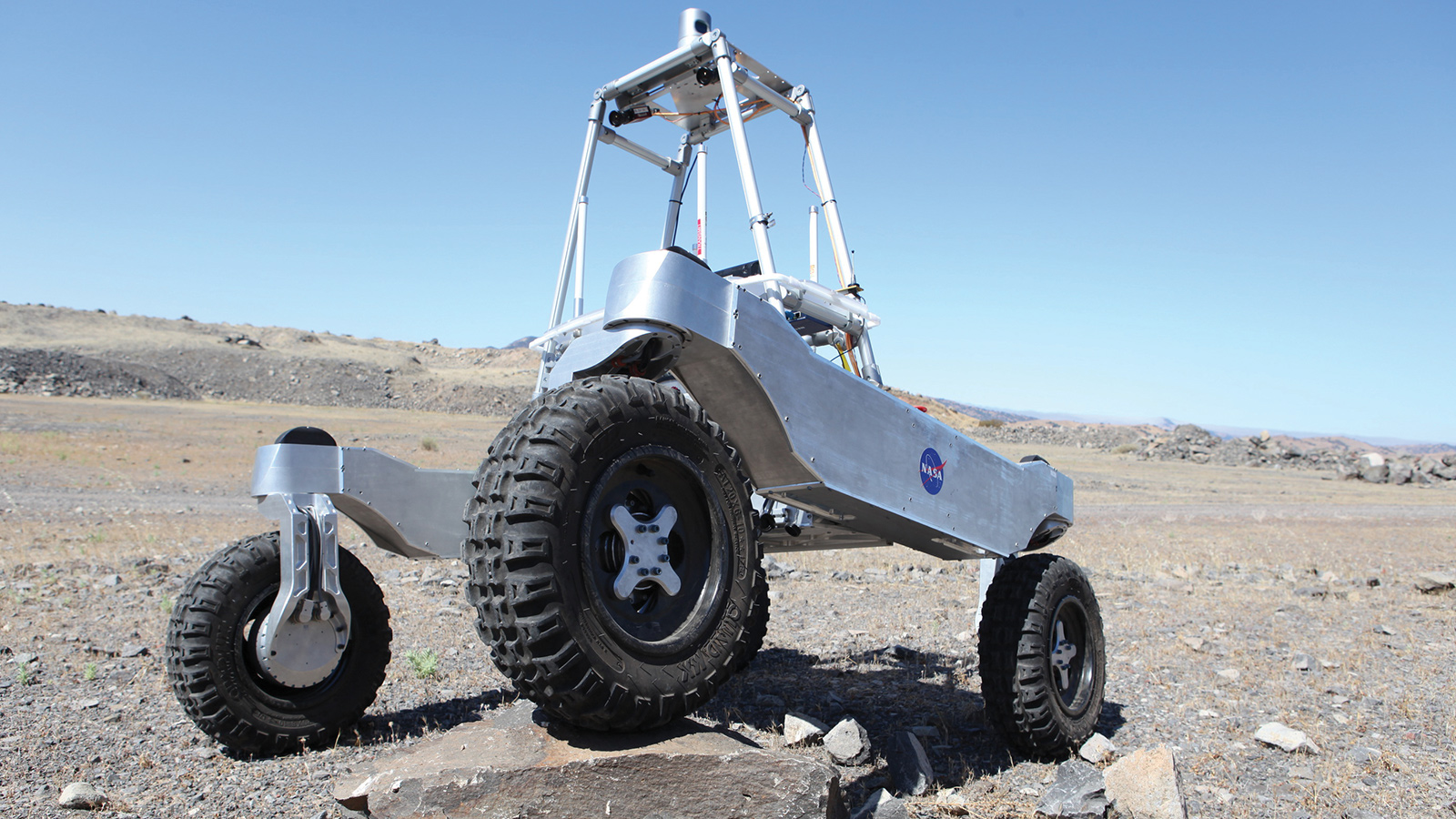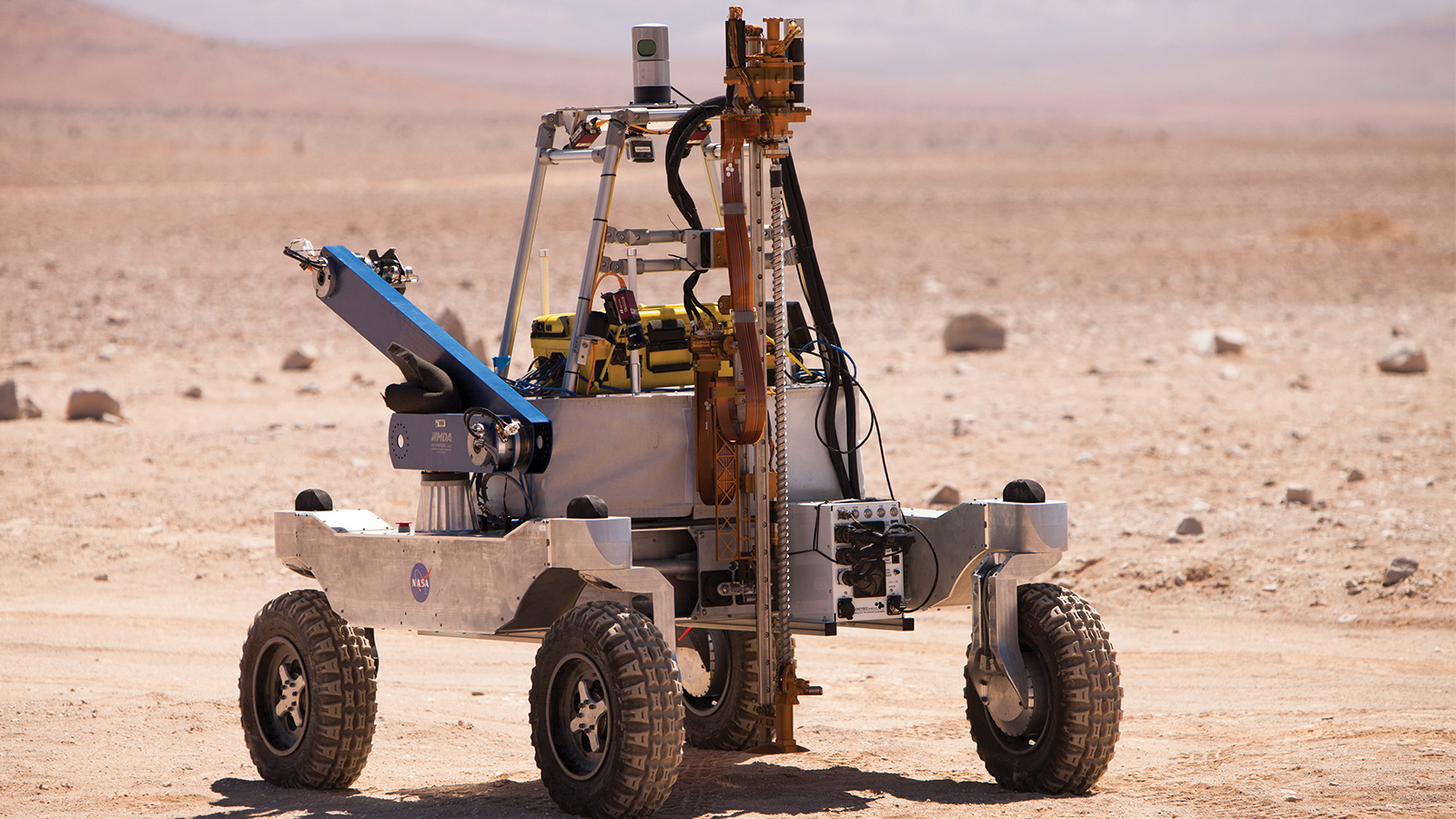Stay Up to Date
Submit your email address to receive the latest industry and Aerospace America news.
Sending an advance team of robots to the moon before U.S. astronauts arrive in 2024 would provide unprecedented opportunities for joint human-robotic exploration and testing. Gordon Roesler, formerly of DARPA, makes the case.
In almost every futuristic picture of lunar habitats, you will see robots. This makes complete sense, for it is often said, “Robots should do the jobs that are dull, dirty and dangerous.” Many operations on the lunar surface will be all three of those.
Lunar regolith (soil) clings to everything and is abrasive. Pushing piles of it onto a habitat to provide shielding would be dirty, boring work that should not require an astronaut with a doctoral degree in geology. As for dangers, the most dangerous locales are also the most potentially valuable. Topping the list are the permanently shadowed regions or PSRs, the deep craters at the lunar poles that sunlight doesn’t enter. These would be highly hazardous for astronauts: Once a new surface spacesuit is developed, it’s unclear whether its design will permit operations in the extremely low temperatures of the PSRs. Also, the surface of the PSRs might not be the powdery regolith of the Apollo missions, but rather unstable terrain. On top of all that, there is no ambient light. That said, the PSRs have allure because they contain water ice, an incredibly valuable resource both for sustaining human presence and for conversion into rocket propellant. We need to get samples back from the PSRs to know how much water we can count on and how easy it will be to extract.
At the moment, when U.S. astronauts return to the moon in 2024, they may not be able to enter the PSRs for safety reasons. But what if robots were available to assist the astronauts in sample collection and to demonstrate how humans and robots work together? This is an issue that NASA can fix with programmatic creativity and help from the industry.
The starting point should be that a robotic advance party cannot become a burden. The 2024 mission has an aggressive schedule. The key challenges of launch vehicle readiness, lander development, gateway development and preparation of new spacesuits are dominating the 2024 planning process. Launching robots with the 2024 lander would increase the propellant requirement unacceptably. As Neil Armstrong said in a pre-Apollo 11 press conference, “If I had one thing to take, it would be more fuel.”
Instead NASA should consider incenting industry to use some of the other landers now under development to deliver some robots separately. NASA has chosen nine companies that will be eligible to compete for contracts to land instruments on the moon under its Commercial Lunar Payload Services program, or CLPS. Independently, Jeff Bezos announced in May that for the past three years Blue Origin has been developing its own lunar lander, called Blue Moon. The nine CLPS selectees advertise payload capacity from 35 kilograms, as proposed by Astrobotic of Pittsburgh, to 500 kg as proposed by Moon Express of Cape Canaveral, Florida. The Blue Moon lander would be in a different category, able to deliver 3,500-6,500 kg of payload to the lunar surface.
NASA could, for example, award a monetary prize to the company that can deliver robots to the moon ahead of the astronauts who would meet up with them. Separately from any prize, there would be numerous benefits to companies and investors that step up to this mission. They will become market leaders in the lunar business, delivering proof positive that landers and robots are reliable and efficient. They will gather data about robot performance and the resources of the moon that will empower them to make a business out of lunar resources. In fact, both kinds of data could be the value proposition — NASA could agree to provide exclusive rights to the data gathered by the human-robot team for a certain period of time. Companies that are interested in commercial lunar propellant production will recognize the value of this priceless, exclusive information.
The administration’s position is that the new lunar activities will be “sustainable.” To achieve sustainability, there is general agreement that robots will be critical to long-term, large-scale operations on the moon. But how well will they do their jobs? How easy will it be to control them? How efficient are they? These are important questions for the design of sustainable lunar complexes. NASA should view the 2024 mission as an opportunity to start answering those questions.
In addition to the mass issue, the robots need to be sent to the moon ahead of the astronauts under a separate initiative for several reasons. To avoid any danger to astronauts, the robot-carrying lander or landers must arrive first. At the same time, the robots must be near enough for useful coordinated work. When the astronauts land, they will “meet up” with the robots and go to work. This is a completely new and compelling mission architecture.
What will astronauts use the robots for? First, they can test how well they work on their own and under human control. Three operational modes can be compared for efficiency, speed of operation and accuracy: autonomous, locally teleoperated and remotely teleoperated from Earth. In autonomous mode, robots would be loosely supervised for safety. In the local mode, an astronaut in the 2024 lunar lander would perceive and react to the local environment by steering the robots and directing their robotic arms. This would ensure that the crew could direct meaningful activities, such as sample gathering, even if NASA does not have a surface spacesuit ready by 2024. In the remote mode, the robots would be teleoperated from Earth, relying on their onboard sensors to provide situational awareness. Based on my experience with humans controlling robots, my guess is that the astronaut in local control will greatly outperform the remote mode or autonomous mode. Automation would relieve her of constant attention to repetitive tasks, but will not permit her to respond to unexpected opportunities. Importantly, the robots never need approach the astronauts closely enough to represent a hazard.
These operational experiments would provide invaluable data in support of the procedures and tools needed for the sustainable lunar habitat of the future. Perhaps there will even be an opportunity for an astronaut to repair a robot or simulate repairing one. Joint human-robot operations can also enhance the scientific yield of the 2024 mission. The rate of sample collection will be greatly increased if robots are involved. Images and samples could be obtained from locations too dangerous for astronauts to enter, such as the PSRs. Those images and samples are critical for answering lunar resource questions, such as:
What is the surface texture, and how well can vehicles traverse it?
What is the water ice content at the surface, and perhaps deeper?
What are some key properties of the regolith, such as thermal conductivity, packing density, and cohesion?
Perhaps the 2024 lander could even be equipped with a chemistry lab so that some of the samples acquired by the robot could be analyzed in real time, rather than waiting for analysis back on Earth. This could be particularly important for measuring water ice content — the key resource for sustainable presence at the lunar South Pole. Without cryogenic storage for samples obtained in the PSRs, delaying analysis until samples arrive at Earth could introduce errors into water content estimates.
A robotic meet-up advance mission would greatly enhance the overall mission value but should not be allowed to delay the human mission. The landing would no longer be just about “flags and footprints,” but a multifaceted mission that directly supports future sustainable lunar endeavors. It is critical for NASA to add this opportunity into its plans. Aerospace companies, large and small, will leap at the opportunity.
Given the nine CLPS awards directed toward lunar science, it only makes sense to leverage them for additional return from the 2024 and subsequent human missions. The labor to construct future lunar colonies will be dominated by robots — for site development, construction, shielding, resource production and scientific purposes. It’s time to figure out how well robots can do these jobs and how best to use them. The five years before humans return to the moon is plenty of time to create and deliver some robotic pathfinders to meet up with our brave 2024 astronauts and give them a hand.
Related Posts
Stay Up to Date
Submit your email address to receive the latest industry and Aerospace America news.






